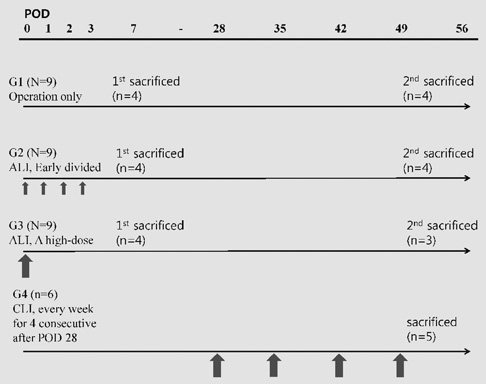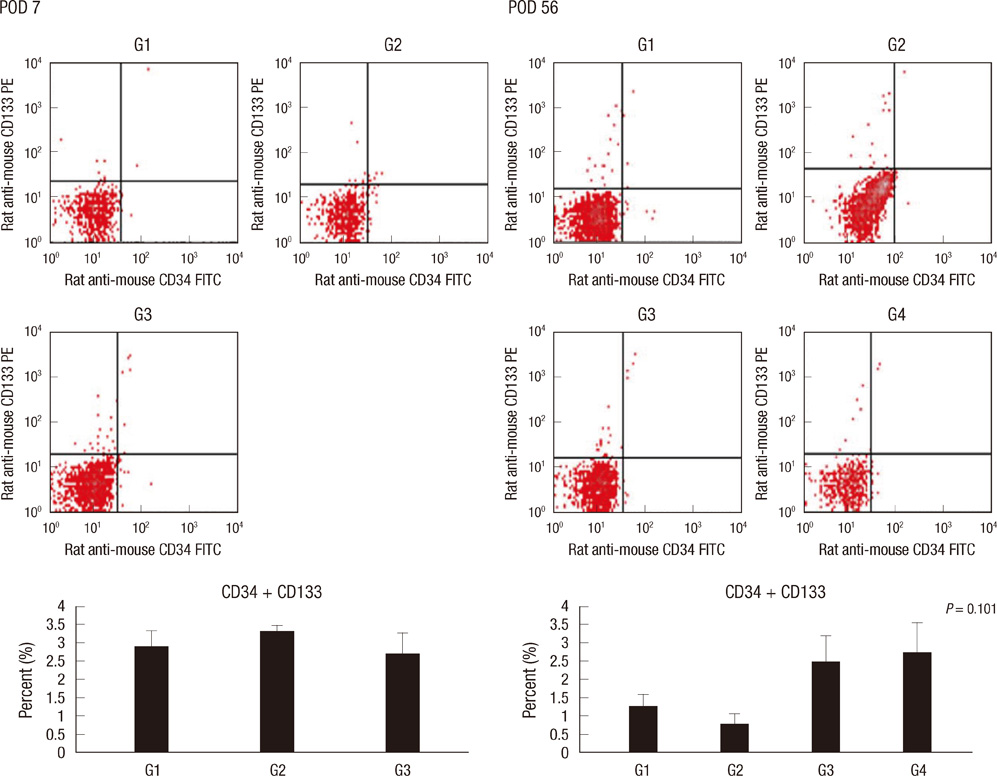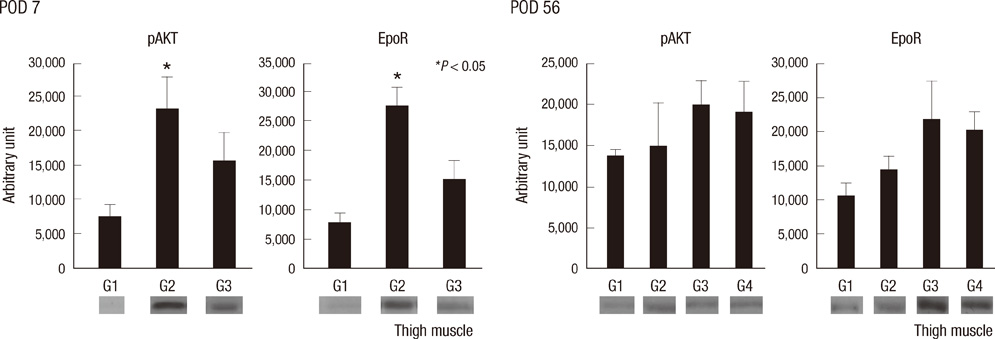J Korean Med Sci.
2012 Sep;27(9):1073-1078. 10.3346/jkms.2012.27.9.1073.
Early Sustained Injections of Erythropoietin Improve Angiogenesis and Restoration of Perfusion in the Ischemic Mouse Hindlimb
- Affiliations
-
- 1Department of Surgery, Seoul National University College of Medicine, Seoul, Korea. jwhamd@snu.ac.kr
- 2Department of Pathology, Seoul National University College of Medicine, Seoul, Korea.
- KMID: 1782142
- DOI: http://doi.org/10.3346/jkms.2012.27.9.1073
Abstract
- This study was conducted to investigate the effects of erythropoietin (Epo) on both acute and chronic limb ischemia (ALI and CLI) and to evaluate the differences in mechanisms according to the method of Epo administration. Hindlimb ischemia was made in BALB/c mice with femoral artery ligation. The mice were divided into four groups: Group 1 (control, no treatment), Group 2 (ALI, early multiple doses), Group 3 (ALI, early single high dose), Group 4 (CLI, late multiple doses). Blood flow ratio significantly increased in Group 2 in 4 weeks. Expression of pAkt and Erythropoietin receptor were significantly higher in Group 2 on postoperative day (POD) 7. The number of CD31- and vascular endothelial growth factor-positive cells were significantly higher in Group 2 on POD 7 and 56. Group 3 and 4 showed a tendency of higher cell counts than the control. The early sustained Epo was effective in improving blood flow through angiogenesis. In chronic phase, weekly multiple dosing of Epo induced angiogenesis, however, the blood flow ratio did not increase significantly. The results of this study suggest that Epo administration during the acute phase followed by maintenance for several days may be important for increasing blood flow and angiogenesis.
Keyword
MeSH Terms
-
Acute Disease
Animals
Chronic Disease
Erythropoietin/*pharmacology
Hindlimb/*blood supply
Ischemia/*metabolism/pathology
Laser-Doppler Flowmetry
Male
Mice
Mice, Inbred BALB C
Neovascularization, Physiologic/drug effects
Proto-Oncogene Proteins c-akt/metabolism
Receptors, Erythropoietin/metabolism
Recombinant Proteins/pharmacology
Vascular Endothelial Growth Factor A/metabolism
Receptors, Erythropoietin
Recombinant Proteins
Vascular Endothelial Growth Factor A
Proto-Oncogene Proteins c-akt
Erythropoietin
Figure
Reference
-
1. Campbell WB, Marriott S, Eve R, Mapson E, Sexton S, Thompson JF. Amputation for acute ischaemia is associated with increased comorbidity and higher amputation level. Cardiovasc Surg. 2003. 11:121–123.2. Ouriel K. Peripheral arterial disease. Lancet. 2001. 358:1257–1264.3. Adam DJ, Beard JD, Cleveland T, Bell J, Bradbury AW, Forbes JF, Fowkes FG, Gillepsie I, Ruckley CV, Raab G, et al. Bypass versus angioplasty in severe ischaemia of the leg (BASIL): multicentre, randomised controlled trial. Lancet. 2005. 366:1925–1934.4. Wenger RH. Mammalian oxygen sensing, signalling and gene regulation. J Exp Biol. 2000. 203:1253–1263.5. Carmeliet P. Angiogenesis in health and disease. Nat Med. 2003. 9:653–660.6. Wright GL, Hanlon P, Amin K, Steenbergen C, Murphy E, Arcasoy MO. Erythropoietin receptor expression in adult rat cardiomyocytes is associated with an acute cardioprotective effect for recombinant erythropoietin during ischemia-reperfusion injury. FASEB J. 2004. 18:1031–1033.7. Lipsic E, Schoemaker RG, van der Meer P, Voors AA, van Veldhuisen DJ, van Gilst WH. Protective effects of erythropoietin in cardiac ischemia: from bench to bedside. J Am Coll Cardiol. 2006. 48:2161–2167.8. Steensma DP, Molina R, Sloan JA, Nikcevich DA, Schaefer PL, Rowland KM Jr, Dentchev T, Novotny PJ, Tschetter LK, Alberts SR, et al. Phase III study of two different dosing schedules of erythropoietin in anemic patients with cancer. J Clin Oncol. 2006. 24:1079–1089.9. Liu C, Shen K, Liu Z, Noguchi CT. Regulated human erythropoietin receptor expression in mouse brain. J Biol Chem. 1997. 272:32395–32400.10. Grimm C, Wenzel A, Groszer M, Mayser H, Seeliger M, Samardzija M, Bauer C, Gassmann M, Reme CE. HIF-1-induced erythropoietin in the hypoxic retina protects against light-induced retinal degeneration. Nat Med. 2002. 8:718–724.11. Wu H, Lee SH, Gao J, Liu X, Iruela-Arispe ML. Inactivation of erythropoietin leads to defects in cardiac morphogenesis. Development. 1999. 126:3597–3605.12. Westenfelder C, Biddle DL, Baranowski RL. Human, rat, and mouse kidney cells express functional erythropoietin receptors. Kidney Int. 1999. 55:808–820.13. Ammarguellat F, Gogusev J, Drueke TB. Direct effect of erythropoietin on rat vascular smooth-muscle cell via a putative erythropoietin receptor. Nephrol Dial Transplant. 1996. 11:687–692.14. Ogilvie M, Yu X, Nicolas-Metral V, Pulido SM, Liu C, Ruegg UT, Noguchi CT. Erythropoietin stimulates proliferation and interferes with differentiation of myoblasts. J Biol Chem. 2000. 275:39754–39761.15. Anagnostou A, Liu Z, Steiner M, Chin K, Lee ES, Kessimian N, Noguchi CT. Erythropoietin receptor mRNA expression in human endothelial cells. Proc Natl Acad Sci U S A. 1994. 91:3974–3978.16. Gäbel R, Klopsch C, Furlani D, Yerebakan C, Li W, Ugurlucan M, Ma N, Steinhoff G. Single high-dose intramyocardial administration of erythropoietin promotes early intracardiac proliferation, proves safety and restores cardiac performance after myocardial infarction in rats. Interact Cardiovasc Thorac Surg. 2009. 9:20–25. discussion 5.17. Agnello D, Bigini P, Villa P, Mennini T, Cerami A, Brines ML, Ghezzi P. Erythropoietin exerts an anti-inflammatory effect on the CNS in a model of experimental autoimmune encephalomyelitis. Brain Res. 2002. 952:128–134.18. Zhang J, Li Y, Cui Y, Chen J, Lu M, Elias SB, Chopp M. Erythropoietin treatment improves neurological functional recovery in EAE mice. Brain Res. 2005. 1034:34–39.19. Yamaji R, Okada T, Moriya M, Naito M, Tsuruo T, Miyatake K, Nakano Y. Brain capillary endothelial cells express two forms of erythropoietin receptor mRNA. Eur J Biochem. 1996. 239:494–500.20. Bianchi R, Buyukakilli B, Brines M, Savino C, Cavaletti G, Oggioni N, Lauria G, Borgna M, Lombardi R, Cimen B, et al. Erythropoietin both protects from and reverses experimental diabetic neuropathy. Proc Natl Acad Sci U S A. 2004. 101:823–828.21. Li L, Okada H, Takemura G, Esaki M, Kobayashi H, Kanamori H, Kawamura I, Maruyama R, Fujiwara T, Fujiwara H, et al. Sustained release of erythropoietin using biodegradable gelatin hydrogel microspheres persistently improves lower leg ischemia. J Am Coll Cardiol. 2009. 53:2378–2388.
- Full Text Links
- Actions
-
Cited
- CITED
-
- Close
- Share
- Similar articles
-
- Effect of Nanoparticle with VEGF in Mouse Ischemic Hindlimb Model
- Effect of Angiogenesis Induced by Consecutive Intramuscular Injections of Vascular Endothelial Growth Factor in a Hindlimb Ischemic Mouse Model
- Angiogenic effects of recombinant thymosin beta4 in a mouse hindlimb ischemia model
- Therapeutic Potential of Human Mesenchymal Stem Cells for Treating Ischemic Limb Diseases
- Toward the Clinical Application of Therapeutic Angiogenesis Against Pediatric Ischemic Retinopathy






